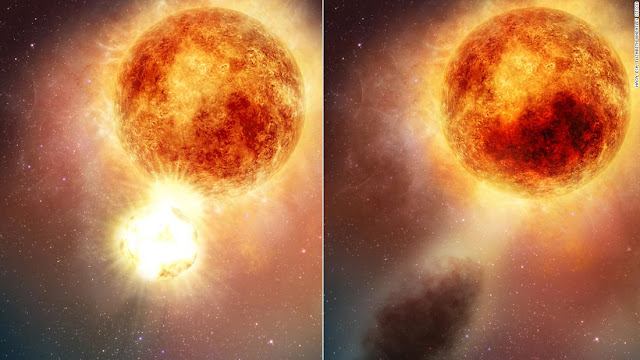Supergiant Betelgeuse had a never-before-seen massive eruption
One of the largest stars in the Orion constellation, the red supergiant Betelgeuse, just had a gigantic stellar outburst that has never been observed before, according to scientists.
Betelgeuse gained notoriety for the first time in late 2019 when the star, which gleams like a crimson diamond in Orion's upper-right shoulder, unexpectedly darkened. In 2020, the supergiant continued to lose brightness.
Scientists have been attempting to find out what happened to the star since since some predicted that it would go supernova.
Now that data from the Hubble Space Telescope and other observatories have been evaluated, scientists think the star had a gigantic surface mass ejection, shedding a significant portion of its visible surface.
"A massive star surface mass ejection has never previously been observed. We are left with a situation that we don't fully comprehend "a remark from Cambridge, Massachusetts-based astronomer Andrea Dupree of the Center for Astrophysics | Harvard & Smithsonian.
"We can directly witness this brand-new phenomena and use Hubble to discern surface features. Real-time observation of the development of stars."
Coronal mass ejections, or CMEs, are periodic outbursts of the star's corona, the outer atmosphere that surrounds our sun. In the event that this space weather affects Earth, satellite-based power systems and communications might be affected.
But compared to a typical coronal mass ejection from the sun, the surface mass ejection Betelgeuse underwent discharged more than 400 billion times as much mass.
The star's life span
Astronomers have been able to observe Betelgeuse's peculiar behavior to learn more about what happens toward the end of a star's existence.
Betelgeuse has grown to enormous proportions and evolved into a red supergiant as a result of burning through fuel in its core. The enormous star has a diameter of 1 billion miles (1.6 billion kilometers).
The star will eventually become supernova, which might briefly be visible from Earth during the day. The celebrity is been having some ferocious tantrums.
Even losing a sizable portion of its surface mass isn't a warning that Betelgeuse is about to blow, according to scientists. Late in their lifetimes, stars can lose a large amount of mass when they burn via nuclear fusion, which can have an impact on their survival.
In an effort to comprehend what transpired, astronomers like Dupree have examined the star's behavior before, during, and after the outburst.
A convective plume that was more than 1 million miles (1.6 million kilometers) broad is thought to have originated from the star itself, according to scientists. A portion of the star's photosphere was peeled off by an explosion brought on by shocks and pulsations produced by the plume.
The fragment of Betelgeuse's photosphere, which was thrown into space and weighed more than the moon, was multiplied by numerous. When observed through Earth-based telescopes, the star's light was obscured by the mass's formation of a huge dust cloud as it cooled.
As one of the brightest stars in the night sky of Earth, Betelgeuse's fading, which lasted for a few months, was visible via both observatories and home telescopes.
recuperating from the explosion
For 200 years, astronomers have tracked Betelgeuse's cycle. The 400-day pulse of this star is essentially a fading and brightening cycle. The fact that that pulse has stopped for the time being is evidence of how important the eruption was.
Dupree likened the blast to the sloshing of an imbalanced washing machine tub and theorized that the blast is still resonating in the star's internal convection cells, which cause the pulsing.
Betelgeuse is progressively recovering, according to data from telescopes, although its surface is still springy while the photosphere is being rebuilt. The star's outer layer has also reverted to normal.
Betelgeuse is still acting in an odd manner, according to Dupree. "The atmosphere is kind of jumping."
The fact that a star has never previously lost so much of its visible surface raises the possibility that surface mass ejections and coronal mass ejections are two entirely distinct phenomena.
The James Webb Space Telescope will provide more opportunities for follow-up observations of the mass expelled from the star and may provide more hints through otherwise unseen infrared radiation.




Comments
Post a Comment